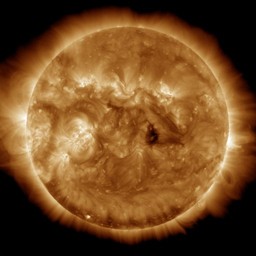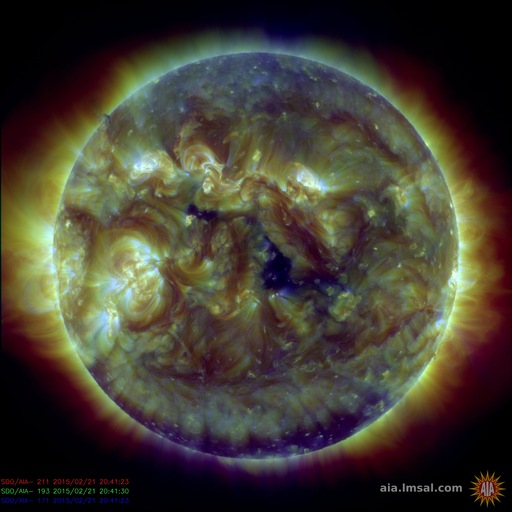OK I'll bite, despite that Dean Pesnell of the SDO team must really love me by now. :)
Most of the info you're after is available on SDO Data pages, if you click on the info icon. Also note that the Fe (Iron) channel composite in your question is equipped with color-keyed channel info bottom left of it, tho it is rather difficult to see at the resolution you used. Here's the description for the composite image:
This image combines three images with different, but very similar,
temperatures. The colors are assigned differently than in the single
images. Here AIA 211 is red, AIA 193 is green, and AIA 171 is blue.
Each highlights a different part of the corona.
So the composite is generated by taking the three different wavelength (given in their names in angstroms) images and combining them per color channel into a single color image. The three inputs are described as (using latest SDO data thumbnails as examples):
AIA 211 (Red channel in Fe composite)

This channel (as well as AIA 335) highlights the active region of the
outer atmosphere of the Sun - the corona. Active regions, solar
flares, and coronal mass ejections will appear bright here. The dark
areas - called coronal holes - are places where very little radiation
is emitted, yet are the main source of solar wind particles.
Where: Active regions of the corona
Wavelength: 211 angstroms (0.0000000211 m) = Extreme Ultraviolet
Primary ions seen: 13 times ionized iron (Fe XIV)
Characteristic temperature: 2 million K (3.6 million F)
AIA 193 (Green channel in Fe composite)

This channel highlights the outer atmosphere of the Sun - called the
corona - as well as hot flare plasma. Hot active regions, solar
flares, and coronal mass ejections will appear bright here. The dark
areas - called coronal holes - are places where very little radiation
is emitted, yet are the main source of solar wind particles.
Where: Corona and hot flare plasma
Wavelength: 193 angstroms (0.0000000193 m) = Extreme Ultraviolet
Primary ions seen: 11 times ionized iron (Fe XII)
Characteristic temperature: 1.25 million K (2.25 million F)
AIA 171 (Blue channel in Fe composite)

This channel is especially good at showing coronal loops - the arcs
extending off of the Sun where plasma moves along magnetic field
lines. The brightest spots seen here are locations where the magnetic
field near the surface is exceptionally strong.
Where: Quiet corona and upper transition region
Wavelength: 171 angstroms (0.0000000171 m) = Extreme Ultraviolet
Primary ions seen: 8 times ionized iron (Fe IX)
Characteristic temperature: 1 million K (1.8 million F)
I've also tried to generate my own composites out of AIA 211, AIA 193, and AIA 171. These are the two tries:

Image above is a RGB channel combine from direct grey scale conversion. It looks pretty nice, but too much red. OK, next try:

That's better, but still not as good as from the SDO team of course. What I did here is to convert input channels into B&W by using the portrait profile in Photoshop, then recombined as RGB components just like before, and also adjusted output color balance a bit. I opted for 6500 K color temperature. And there was a bit of contrast adjustment too. It's still not exactly like the composites from SDO tho:

OK, enough of playing with data. Let's try to answer your questions more directly:
What are those filters made of?
I have no idea. They're multilayer-coated optical filters that let through incident light in wavelengths as described above. I presume they're high quality and were really expensive though. :) My best guess would be they were made by multiple vacuum deposition layers of partially reflecting dielectric compounds on a glass substrate. This would be the so-called "traditional coating", but there are other processes that could have been uses for AIA.
What is the exposure time for these photos?
If you look at individual channel timestamps in the image, they're at most a few seconds apart. AIA is capable of taking at least one image each second. But changing optical path (AIA uses four telescopes) and filters will take a few seconds, which will reflect in timestamps. And each filter will likely require slightly different exposure times. The browse data you're looking at (Level 2) are processed from raw (Level 0) data stream and corrected to a standardized exposure time. Refer to the Guide to SDO Data Analysis documentation for more info.
Does the unit use the kind of light recording surface a digital camera
does, or is it a surface capable of recording in the EUV range?
AIA uses 4Kx4K resolution CCD (Charge-Doupled Device) sensors that operate at about -70° C (source). Keeping sensors at low enough temperatures enables them to record in visible and UV range with low thermal noise. CCDs are a bit expensive to make, and you'd usually find cheaper CMOS sensors in your consumer grade appliances. But they are widely used in various professional markets, including astronomy.
Some additional sources:






